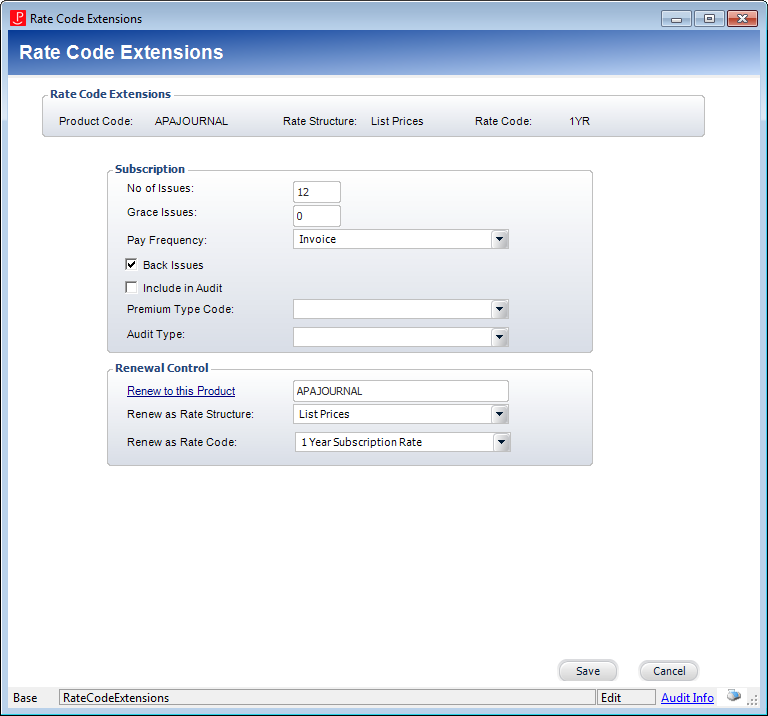The Rate Code Extensions screen displays, as shown below.

In addition to defining the number of volumes and grace issues for the subscription product, you can select the pay frequency, whether or not subscribers can purchase back issue, whether or not subscription orders with this rate will be included in the audit, the premium type code, and the audit code. Additionally, at the rate code level, you can renew the product as a different product, or the same product with a different rate code. For more information on this, please Defining Subscription Product Renewal Options.
To add rate code extensions:
1. On the
Rate and
Pricing screen, click Rate Code Extensions.
The Rate Code Extensions screen displays, as shown below.

2. Enter the Number of Issues.
3. Enter the Grace Issues.
4. Select the Pay Frequency from the drop-down.
5. Select whether this rate code includes Back Issues.
6. Select whether this rate code will be Included in Audit.
7. Select the Premium Type Code from the drop-down.
8. Select the Audit Type from the drop-down.
 A rate code
extension must exist with an Audit Type of “Replacement Issue” in order
for a replacement issue order to be made.
A rate code
extension must exist with an Audit Type of “Replacement Issue” in order
for a replacement issue order to be made.
9. For more information on the Renewal Control section, please see Defining Subscription Product Renewal Options.
10. Click Save.
Screen Element |
Description |
|---|---|
Subscription |
|
No of Issues |
Text box. The number of issues or volumes that will be provided with this rate code. When a subscription order is placed, this value determines the end date. Issue-based journals default to 12 issues. Volume-based journals default to 1. |
Grace Issues |
Text box. The number of issues a subscriber will receive beyond the paid subscription. The grace date for the subscription product is calculated as Cycle End Date + Duration of Grace Issues. |
Pay Frequency |
Drop-down. The time frame the customer must pay. For example, Invoice indicates the customer must pay immediately and Monthly indicates the customer can pay on a monthly schedule. If Monthly is selected, the order is automatically created with a monthly payment schedule but can be overridden on the Order Entry screen. Values in the drop-down are populated based on the fixed codes defined for the "PAY_FREQUENCY" system type. |
Back Issues |
Checkbox. When checked, indicates subscribers can purchase previously run issues. Used with Order Entry to determine whether to provide back issues.
If this checkbox is selected and this product is manually added as a subscription benefit to a membership order, the customer will receive back issues for the length of their membership.
|
Include in Audit |
Checkbox. When checked, indicates subscription orders with this rate will be included in the audit. The ABC and BPA audits will include subscriptions.
|
Premium Type Code |
This has not been implemented. |
Audit Type |
Drop-down. Used to determine in which section of an audit report subscription orders with this rate code will be included. Values are populated based on the fixed SUB "AUDIT_TYPE" system type. The options include: · Advertiser and Agency – subscriber is an advertiser or agency; these are non-qualified subscriptions. · Individual – subscriber is an individual subscriber; these are qualified subscriptions. · Membership Benefit Paid – subscribers are getting subscriptions as a benefit of membership and a portion of their membership dues is allocated to the cost of the subscription; these are qualified subscriptions. · Membership Benefit Unpaid - subscribers are getting subscriptions as a benefit of membership for which no portion of their membership fee is allocated to the subscription cost; these are qualified subscriptions. · Multi-copy same addressee – multiple subscriptions are being fulfilled to the same subscriber at the same address; these are qualified subscriptions. · Non Qualified Digital – the subscriber is receiving a digital subscription; these are not qualified subscriptions. · Others – subscribers who don’t fit in any other category; these are not qualified subscriptions. · Other Paid – subscribers who don’t fit in any other category but who paid for their subscription; these are not qualified subscriptions. · Replacement Issue – identifies a rate code that is used for order lines to fulfill a replacement issue; replacement issues are not considered by BPA audit reports. · Rotated or Occasional – identifies subscriptions that are not fulfilled on a regular basis or are rotated; these are not qualified subscriptions. · Sponsored individually addressed – subscribers who are receiving subscriptions that are sponsored and addressed to them individually; these are qualified subscriptions. · Single Copy Sales – identifies issues that were sold and fulfilled as a single issue, rather than as part of a regular subscription; single copy sales count as qualified circulation. · Allocated to Trade Shows – identifies issues that are handed out at trade shows; these issues do not count as qualified circulation. |